AI in HR: How Artificial Intelligence Is Changing Human Resources
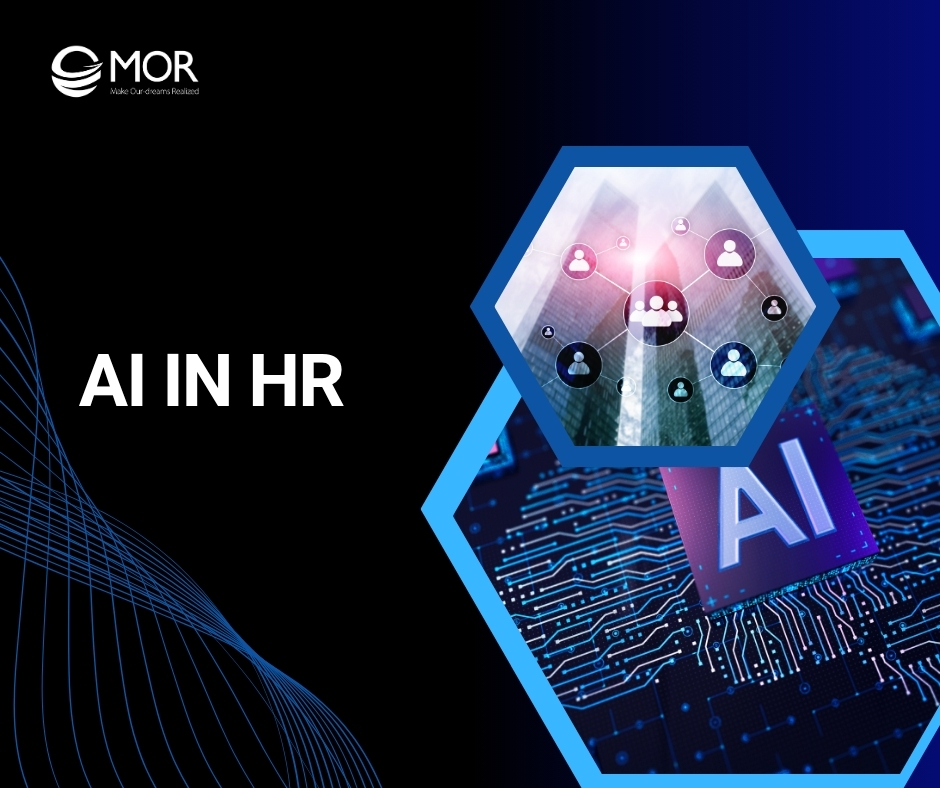
AI in HR is transforming how businesses recruit, develop, and retain talent. From automating repetitive tasks to predicting workforce trends, artificial intelligence is redefining the future of human resources. This MOR Software’s guide shows how companies use AI for HR to improve efficiency, elevate employee experience, and make smarter, data-driven decisions.
What Is AI in HR?
AI in HR refers to the use of artificial intelligence to reshape how human resources teams operate. Instead of relying on manual processes, HR professionals can now use machine learning algorithm, predictive analytics, and AI and machine learning in HR systems to automate repetitive work, interpret data, and make informed decisions faster. These tools also enhance the overall employee experience by freeing HR teams from time-consuming administrative duties, allowing them to focus on people-centered strategies that boost engagement and retention.
Modern human resources AI systems can analyze vast amounts of workforce data, spot behavioral trends, and even simulate realistic human interactions. Through these capabilities, human resource development departments are evolving from administrative support units into strategic partners that directly influence business outcomes. This shift is helping HR leaders align more closely with company growth objectives and make data-backed decisions about hiring, training, and employee well-being.
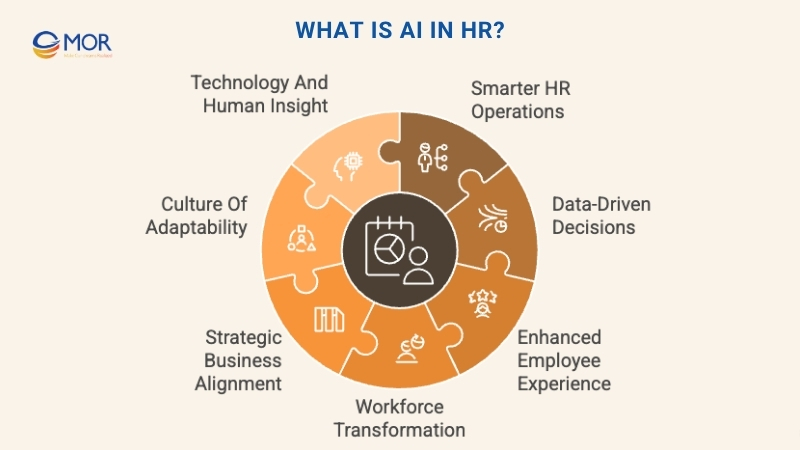
Today’s HR teams face constant challenges: changing employee expectations, a tightening global labor market, and a widening skills gap. As technology continues to advance, AI in HR is becoming a vital part of workforce transformation. A recent IBM study revealed that only about 20% of executives believe HR currently leads their organization’s future-of-work strategy. This statistic highlights a growing need for HR professionals to take ownership of how businesses adapt to AI-driven change, an area no longer limited to IT departments alone.
In the years ahead, AI in HR will impact companies in two powerful ways. First, it will streamline HR operations by improving how organizations manage and predict talent needs. Second, it will encourage a culture of adaptability, where employees and leaders embrace new ways of working with technology. These outcomes demand both strategic planning and open-minded leadership, but the rewards are substantial.
Employee resistance remains one of the strongest barriers to innovation. Companies that create meaningful employee experiences are more likely to outperform competitors in revenue growth, by as much as 31%, according to industry research. As markets shift rapidly, HR departments are becoming essential to maintaining agile and resilient organizations. In fact, 57% of global CEOs now believe cultural change matters more than technical upgrades when transforming into a data-driven enterprise.
Through automating routine processes, analyzing workforce data, and building personalized development systems, AI in HR empowers teams to drive business change. It represents the true merging of human insight and technology, where AI-powered HRMS software solutions make operations smarter and more transparent while preserving the empathy and trust that define great workplaces.
Core Types of AI in HR Applications
Modern HR teams rely on several AI in HR technologies that work together to manage data, automate communication, and support smarter decisions. Each system performs a unique role but often interacts with others. For instance, a digital HR assistant might use conversational AI in HR, natural language processing, generative AI in HR, and machine learning to understand employee questions and take the right actions. Together, these technologies create an ecosystem of intelligent, connected tools that make HR operations faster, more responsive, and data-driven.
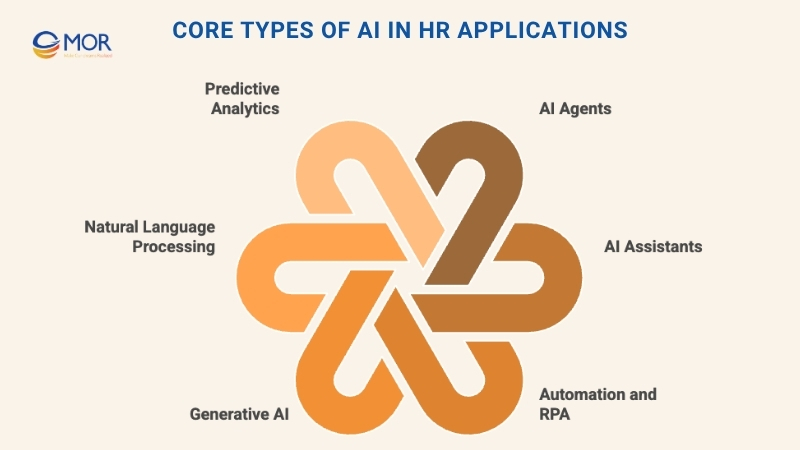
AI Agents
AI agents are self-directed systems built to execute tasks or reach goals with minimal human input. These AI agent frameworks remember past interactions, adapt over time, and improve through experience. In AI in HR recruitment, they can scan job boards, analyze profiles, and shortlist qualified candidates automatically. Within employee management, AI agents manage routine tasks like benefits enrollment or respond to common HR inquiries around policies and payroll. They also support compliance by tracking regulatory updates and alerting HR teams when internal rules need revision.
Over time, these agents evolve into dependable digital coworkers that handle repetitive or time-sensitive tasks efficiently. This frees HR professionals to focus on strategic planning and employee engagement, making AI for HR a crucial component of modern workforce management.
AI Assistants
AI assistants act as intelligent virtual helpers that use natural language processing tools to interact with users in a conversational way. Unlike older chatbots, these systems can understand complex questions, remember previous interactions, and personalize responses based on user preferences. In using AI in HR, these assistants play a key role in streamlining everyday communication and guiding employees through internal processes.
They can answer common HR questions, help with time-off requests, or walk new hires through onboarding steps like document submission and orientation. For instance, large enterprises have adopted internal tools similar to IBM’s AskHR, which automates more than 80 HR workflows and saves thousands of work hours each quarter. This kind of HR AI software not only boosts efficiency but also improves the overall employee experience by making HR support accessible anytime.
Automation and Robotic Process Automation
Automation and RPA technologies handle repetitive back-office tasks such as data entry, payroll calculations, or attendance tracking. While not full-fledged artificial intelligence, they complement AI in HR by speeding up operations and improving accuracy. These systems can sort job applications, process updates in employee databases, and generate reports automatically.
When combined with AI HR software, RPA becomes even more powerful, reducing manual errors and freeing HR professionals to focus on more analytical and strategic initiatives that drive long-term workforce growth.
Generative AI
Generative AI in HR refers to technology that creates new, original content by learning from large data sets. It helps HR teams produce materials that once required extensive manual work. From writing detailed job descriptions and customized interview questions to developing personalized onboarding materials, this technology accelerates every content-heavy process in HR.
It also supports internal communication by drafting and updating company-wide messages, policy documents, and tailored announcements for specific employee groups. Integrating AI-powered HR solutions like generative systems, HR departments can save valuable time, improve message consistency, and ensure every piece of communication feels relevant to its audience.
Natural Language Processing (NLP)
Natural language processing (NLP) enables machines to understand, interpret, and respond to human language. Within AI in HR, it helps organizations analyze surveys, feedback forms, and employee chats to identify trends in sentiment and engagement. NLP can scan resumes to match candidates with roles, categorize performance review comments, and reveal patterns in communication that might otherwise go unnoticed.
This level of analysis allows HR leaders to make more informed decisions, strengthen workplace culture, and address issues before they escalate. As part of modern HR AI software, NLP transforms unstructured text into actionable insights, helping companies stay attuned to the real pulse of their workforce.
Predictive Analytics
Predictive analytics uses historical and real-time data to forecast what might happen next. In AI in HR, this capability transforms how organizations plan, hire, and retain talent. By analyzing trends in hiring, turnover, and performance, predictive systems can anticipate future staffing needs or highlight departments at risk of skill shortages.
They’re also invaluable during salary reviews, helping HR teams assess compensation benchmarks and maintain pay equity. Beyond that, predictive models can spot early signs of burnout or disengagement, giving managers time to intervene before issues grow. As workday AI and similar platforms continue advancing, predictive analytics will guide decisions about training, reskilling, and workforce development, ensuring teams stay agile and prepared for the future.
How Companies Apply AI in HR Operations
Organizations are now applying AI in HR throughout the entire employee journey, from hiring to career development and retention. These AI in HR examples show how automation and data analytics reshape traditional HR processes, helping teams move faster, make consistent decisions, and create better employee experiences. Below are the main areas where intelligent systems are transforming HR operations.
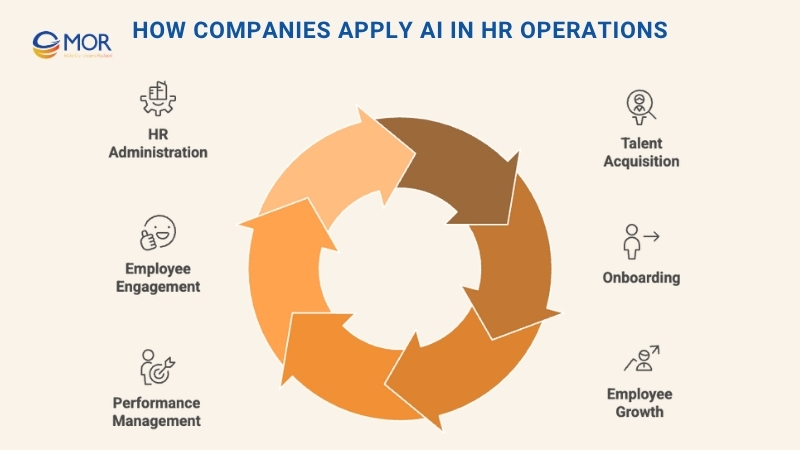
Talent Acquisition
Recruitment is one of the most common applications of AI in HR recruitment, where technology helps companies attract, screen, and select top talent. Intelligent algorithms scan job boards, professional networks, and third-party databases to identify candidates whose skills and experience match open roles. Some platforms even generate tailored job postings for different audiences, maintaining a steady flow of qualified applicants.
During resume screening, AI compares candidate profiles with job requirements to minimize bias and improve accuracy. Automated enterprise scheduling software coordinate interviews, while transcription and meeting summarization features help recruiters focus on decision-making rather than logistics.
A real-world example comes from FloCareer, which leverages AI HR software to search a database of over 160 million professionals, automate interview scheduling, and improve hiring diversity. With AI taking over routine steps, recruiters gain more time to build relationships and evaluate cultural fit, turning hiring into a faster and more strategic process.
Onboarding
The onboarding phase is becoming more dynamic thanks to AI in HR. With smart personalization, new employees receive training and resources tailored to their specific role, department, and previous experience. Interactive virtual assistants use conversational AI in HR to walk newcomers through company policies, benefits, and procedures at their own pace, ensuring a consistent and engaging experience.
Agent-based systems can handle repetitive tasks like setting up employee accounts, generating credentials, and processing paperwork automatically. Some tools even track engagement levels to identify employees who might need extra guidance or support. This blend of automation and personalization helps HR teams deliver smoother onboarding, reduce manual effort, and create a more welcoming start for every hire.
Employee Growth and Development
AI in HR also transforms how organizations support continuous learning and career advancement. Personalized learning systems analyze employee goals, performance data, and skill gaps to recommend relevant courses or certifications. These adaptive tools help employees learn faster and stay aligned with company objectives.
Advanced analytics and AI-powered HR solutions enable HR teams to map internal talent, identify future leaders, and plan succession strategies more effectively. By automating routine tasks and customizing learning paths, businesses build stronger, future-ready teams while keeping employees engaged and motivated to grow within the organization.
Performance Management
AI automation is reshaping how organizations manage performance across teams and departments. With AI in HR, continuous feedback systems now track progress in real time and highlight performance trends that might otherwise go unnoticed. These tools help managers hold more consistent check-ins, reduce bias, and strengthen employee development.
AI-driven analytics evaluate data across projects and departments, revealing insights into productivity and collaboration. Automated reporting tools eliminate manual work, making performance reviews faster and more objective. IBM, for example, used an AI agent to streamline its quarterly promotion process, automatically gathering and formatting performance data for over 17,000 employees, a shift that freed HR teams from heavy administrative work and improved accuracy.
Employee Engagement and Experience
Enhancing engagement is one of the most powerful outcomes of using AI in HR. Intelligent systems create personalized experiences that respond to employee needs, from tailored communication to proactive support. Automated feedback analysis and sentiment tracking give HR leaders a real-time pulse on morale, helping them act before issues escalate.
AI-based self-service platforms also empower employees to handle common HR requests independently, reducing delays and paperwork. With more time freed from repetitive tasks, HR professionals can focus on meaningful initiatives that strengthen workplace culture. These innovations, powered by human resources AI, lead to higher satisfaction, stronger retention, and more connected organizations overall.
HR Administration and Operations
Modern HR teams rely on AI in HR to simplify and strengthen daily administrative work. Automated systems now manage data entry, report creation, and document tracking, reducing manual effort and speeding up response times. AI-powered self-service platforms let employees access information, submit requests, or check HR policies anytime, without needing direct assistance.
Compliance monitoring tools use predictive algorithms to detect potential risks early, while workforce analytics transform raw HR data into meaningful insights for strategic planning. These capabilities, built into AI HR software, help organizations operate more efficiently and make better, data-backed decisions.
Minimizing repetitive work, AI gives HR professionals the space to focus on what truly matters: employee engagement software, well-being, and strategic collaboration with leadership. This combination of automation and human touch allows HR operations to deliver greater long-term value across the entire organization.
Key Benefits of AI in HR Management
The advantages of AI in HR go far beyond automation. When applied strategically, it enhances productivity, improves decision-making, and creates a more engaging and personalized experience for employees across every stage of their journey.
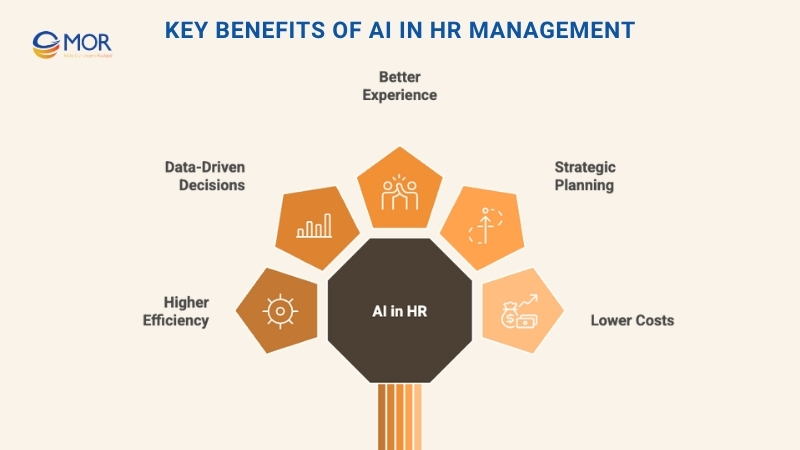
Higher Efficiency and Productivity
The adoption of AI in HR is transforming how teams handle daily operations. By automating repetitive administrative tasks, HR professionals can dedicate more time to strategy, people management, and culture building. Digital workflow automation replace traditional paperwork, cutting down manual errors and improving turnaround speed.
Because AI-powered HR solutions operate continuously, employees receive support around the clock, no matter the time zone. Whether processing payroll, answering questions, or updating records, AI ensures consistency and quick response. This constant availability builds smoother operations and helps HR deliver measurable business value through greater productivity and focus.
Smarter, Data-Based Decisions
Integrating AI in HR enables leaders to make decisions grounded in facts rather than instinct. Predictive models detect potential challenges early, like turnover risks or skill shortages, allowing proactive action before problems grow. Advanced analytics highlight trends across teams, helping organizations plan for future talent needs.
AI also ensures consistency through standardized benchmarking of KPIs, creating a unified view of workforce performance. With these insights, HR teams can align data with business goals, transforming intuition-led decisions into data-driven strategies that strengthen long-term growth.
Better Employee Experience
Implementing AI in HR greatly improves how employees interact with their workplace. Intelligent systems personalize every touchpoint, from onboarding to career development, based on each person’s goals, preferences, and learning style. Employees can access HR support anytime through virtual assistants, receiving instant answers and guidance without waiting for office hours.
AI-driven workflows also remove unnecessary bottlenecks, minimizing the friction that often causes frustration. Personalized career recommendations powered by AI for HR give staff clearer pathways to growth, helping them build skills that align with both personal ambitions and business goals.
Together, these innovations make HR interactions smoother, faster, and more human-centered. The result is a more engaged workforce, higher retention, and stronger overall satisfaction, benefits that translate directly into better organizational performance.
Stronger Strategic Planning
With AI in HR, human resources evolves from an administrative support function into a strategic partner that drives business growth. AI-powered analytics provide deep visibility into workforce trends, helping organizations understand employee needs, skill gaps, and team dynamics. These insights enable smarter decisions about hiring, development, and succession planning.
By analyzing workforce data, leaders can map roles and skills for the future, design more agile structures, and prepare for new modes of work. This strategic use of AI and machine learning in HR allows companies to anticipate change rather than react to it, ensuring that talent strategies stay aligned with long-term business goals.
Lower Operational Costs
Adopting AI in HR can significantly reduce HR-related expenses while improving output quality. AI automation tools shorten recruitment cycles, lower hiring costs, and optimize learning investments through personalized training recommendations. Intelligent workflow analysis identifies inefficiencies, eliminating redundant steps and cutting manual labor.
As AI HR software continues to improve accuracy and speed across processes, organizations gain measurable returns on investment. The resources saved can then be reinvested into innovation, employee engagement, and strategic initiatives that strengthen overall business performance.
Top AI Tools Transforming HR Functions
Today’s examples of AI in HR include a range of powerful tools that help companies recruit smarter, improve engagement, and guide long-term workforce planning. From automation to analytics, these technologies enable HR professionals to work smarter, not harder, making decisions backed by real-time data and creating more meaningful employee experiences.
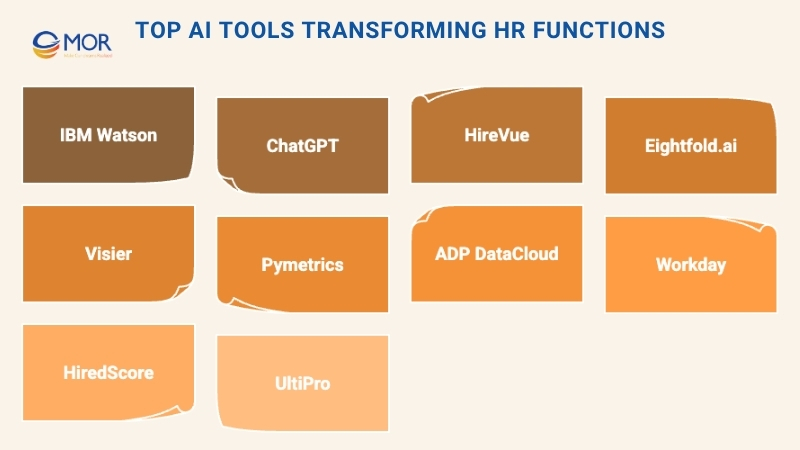
IBM Watson
How it works: IBM Watson is a comprehensive enterprise AI platform that brings automation and analytics to HR operations. It supports key areas like recruitment, employee engagement, and workforce forecasting through machine learning and natural language processing.
How it supports HR: IBM Watson analyzes resumes, ranks candidates based on suitability, and predicts engagement trends using historical data. Its predictive models guide HR leaders in understanding workforce sentiment and improving retention. By applying AI-powered HR solutions like Watson, organizations gain faster insights and stronger, data-driven decision-making across every stage of the employee lifecycle.
ChatGPT
How it works: ChatGPT by OpenAI is a conversational AI in HR tool that communicates naturally with users, simulating human-like dialogue. Its advanced language model allows it to understand context, provide detailed answers, and adapt to different communication styles.
How it supports HR: Many organizations integrate ChatGPT to manage repetitive interactions, answering employee questions, guiding new hires through onboarding, and assisting candidates during the recruitment process. It serves as a virtual HR assistant that operates 24/7, reducing wait times and improving communication. By handling routine queries, ChatGPT gives HR professionals more bandwidth to focus on strategic initiatives and employee engagement.
HireVue
How it works: HireVue is an AI in HR recruitment platform that uses video interviewing and data analytics to assess candidates efficiently. It combines deep machine learning, facial analysis, and natural language processing to evaluate communication style, confidence, and relevant skills.
How it supports HR: HireVue streamlines the hiring process by analyzing recorded interviews and ranking applicants based on job fit and performance potential. This approach allows recruiters to identify top talent faster and spend more time on meaningful final interviews. By automating early-stage screening, HireVue helps HR teams reduce bias, accelerate hiring, and maintain a consistent, data-backed evaluation process.
Eightfold.ai
How it works: Eightfold.ai is an advanced AI for HR platform focused on talent management and career development. It leverages deep learning to align the right candidates with the right roles while supporting internal mobility and workforce growth.
How it supports HR: Eightfold.ai evaluates candidate skills, career paths, and potential to predict success in specific positions. Beyond recruitment, it identifies skill gaps within teams and recommends upskilling programs to strengthen future readiness. By combining predictive insights with personalized learning suggestions, Eightfold.ai helps HR build a more agile and capable workforce.
Visier
How it works: Visier is a workforce analytics platform that turns raw HR data into actionable intelligence. It helps organizations visualize trends, track retention, and plan for future staffing needs.
How it supports HR: Visier empowers HR leaders to make informed, data-driven decisions by revealing insights on turnover, productivity, and engagement. Its predictive modeling anticipates workforce shifts, enabling proactive strategies for talent retention and succession planning. Integrated into AI in HR ecosystems, Visier transforms people analytics into a core driver of organizational success.
Pymetrics
How it works: Pymetrics combines neuroscience-based assessments with artificial intelligence to connect candidates to roles that best match their abilities and personality traits. Using data-driven insights, it helps organizations make smarter and fairer hiring decisions.
How it supports HR: Through interactive, game-style assessments, Pymetrics measures cognitive, social, and emotional attributes without relying on traditional résumés. This method reduces unconscious bias and provides a clearer picture of each applicant’s strengths and potential. By integrating AI in HR, Pymetrics supports inclusive hiring and builds teams that perform better over time.
ADP DataCloud
How it works: ADP DataCloud is a workforce analytics and payroll intelligence platform that centralizes employee data for easier reporting and analysis. It supports decision-making in payroll management system, attendance, and HR compliance.
How it supports HR: ADP DataCloud uses predictive analytics to uncover trends in workforce performance, payroll accuracy, and benefits management. By automating repetitive tasks and improving visibility into workforce metrics, it enables HR leaders to focus on strategy rather than administration. As part of modern AI HR software, ADP DataCloud enhances accuracy, efficiency, and long-term cost savings for organizations.
Workday
How it works: Workday is a unified human capital management platform that uses AI and machine learning to enhance HR operations, from payroll and talent management to workforce analytics. It provides a single system to manage and analyze employee data at scale.
How it supports HR: With workday AI, HR teams gain real-time insights into performance, engagement, and development. Machine learning models personalize recommendations for training, promotion readiness, and career growth. By aligning employee development with company objectives, Workday helps organizations build a workforce that grows strategically and sustainably.
HiredScore
How it works: HiredScore is an intelligent recruitment platform that leverages machine learning and natural language processing to automate and improve candidate evaluation. It integrates seamlessly with applicant tracking systems to optimize hiring workflows.
How it supports HR: HiredScore’s predictive algorithms analyze resumes, experience, and behavioral data to identify top candidates quickly. By ranking and prioritizing applicants, it saves recruiters hours of manual screening time. This integration of AI in HR not only accelerates recruitment but also ensures fairer, data-backed decisions that lead to stronger hires.
Ultimate Software’s UltiPro
How it works: UltiPro is a cloud-based AI HR software platform designed to manage the entire employee lifecycle, from hiring and payroll to development and retention. It integrates advanced analytics and automation to give HR teams a complete picture of workforce performance.
How it supports HR: UltiPro uses artificial intelligence to analyze engagement, turnover, and performance data, helping organizations identify patterns that influence retention and productivity. Its intuitive dashboards provide HR leaders with actionable insights to make better strategic decisions. By combining analytics with automation, UltiPro enhances the effectiveness of AI in HR, ensuring every stage of the employee journey is supported by data-driven intelligence.
Best Practices to Prepare for AI in HR Adoption
Building an AI in HR strategy requires more than just new technology, it demands structure, clarity, and purpose. Before implementing intelligent systems, organizations need to lay the groundwork to ensure long-term success. Below are key practices that help HR teams become truly AI-ready.
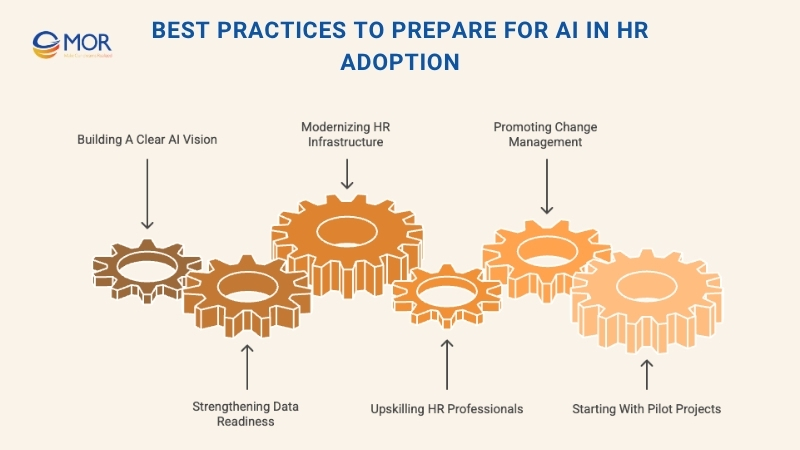
Building a Clear AI Vision
The first step toward effective adoption is defining a clear vision for how AI will enhance HR and business performance. HR leaders should set measurable goals such as shortening recruitment cycles, improving engagement scores, or boosting retention. These objectives guide how AI in HR will integrate into existing workflows and where it can create the most impact.
A strong vision acts as a roadmap for transformation. It keeps every initiative aligned with strategic priorities and prevents teams from deploying AI just for novelty. By identifying high-value areas early, organizations can focus investments where AI-powered HR solutions deliver tangible results, both for the business and its people.
Strengthening Data Readiness
A strong data foundation is essential for successful AI in HR adoption. Before implementation, organizations should assess the current state of their HR data, identifying missing fields, inconsistencies, and outdated or biased information. Data governance plays a crucial role here, ensuring accuracy, transparency, and accessibility across all systems.
This process includes cleaning and standardizing datasets, defining ownership and permissions, and setting clear rules for how data is collected, stored, and used. Privacy compliance must also be built into every step, especially when handling sensitive employee information.
To make AI and machine learning in HR effective, data must be unified across platforms rather than locked in silos. When HR systems share consistent, high-quality data, AI tools can deliver reliable insights that strengthen workforce planning, diversity monitoring, and long-term strategy. Without data readiness, even the most advanced machine learning models will struggle to generate meaningful results.
Modernizing HR Infrastructure
For AI in HR to function effectively, a solid and secure technology foundation is essential. HR teams should start by reviewing their existing system architecture to assess whether it can support AI integration, considering factors like computing capacity, data storage, and connectivity. Evaluating the current HRIS setup also helps identify where AI HR software can plug in smoothly or replace outdated systems.
Security must be built into every layer of the infrastructure. Strong encryption, access management, and continuous auditing protect sensitive employee data from breaches or misuse. Equally important is interoperability: AI tools should connect easily to existing platforms through APIs to ensure seamless data exchange and a consistent user experience.
Finally, infrastructure planning should anticipate future growth. Scalable cloud environments and modular architectures allow organizations to expand AI capabilities gradually, supporting a more agile, long-term transformation of HR operations.
Upskilling HR Professionals
To make the most of AI in HR, teams must be equipped with the right skills to collaborate effectively with intelligent systems. Upskilling initiatives should cover both technical knowledge and strategic thinking. HR professionals need a solid grasp of how AI technologies operate, where they add value, and how to apply them responsibly within daily processes.
Data literacy is now a must-have skill. HR teams should know how to interpret AI-generated insights, ask the right questions, and translate data into actionable strategies. Beyond technical skills, strong change management abilities are vital to lead organization-wide transformation as AI reshapes workflows and employee interactions.
Ongoing professional development should also focus on ethical AI use, compliance, and governance. By understanding how AI-powered HR solutions impact decision-making and fairness, HR teams can ensure AI adoption remains transparent, human-centered, and aligned with company values.
Promoting Change Management and a Culture of Innovation
Adopting AI in HR isn’t just about deploying technology, it’s about reshaping mindsets. HR leaders must foster a culture where AI diversity is viewed as a partner that enhances human capability, not a replacement. Transparent communication about how automation supports higher-value work helps employees see AI as an enabler of growth and creativity.
Encouraging experimentation and continuous learning is key. HR teams should be given the space to explore AI-powered HR solutions, share best practices, and learn from early results. Leadership must also lead by example, showing openness to new tools and demonstrating commitment to supporting teams throughout the transition. This human-centered approach builds trust, accelerates adoption, and nurtures enthusiasm for innovation across the organization.
Starting With Pilot Projects Before Scaling
Launching small, focused pilot projects allows organizations to explore AI in HR safely while gaining hands-on experience. Pilots should target specific, measurable objectives, like automating candidate screening or improving employee feedback analysis, and include clear performance metrics to evaluate both impact and usability.
Insights gained from pilot results help refine future implementations and set realistic expectations for larger rollouts. As adoption expands, organizations should balance innovation with stability, ensuring each stage of growth maintains data quality, security, and user satisfaction. The most successful transformations identify high-value use cases early, prove them through pilot programs, and then scale strategically to achieve sustainable, enterprise-wide results.
MOR Software – Your Trusted Partner for AI In HR Solutions
At MOR Software, we help businesses bring AI in HR to life by developing and integrating intelligent systems that simplify how organizations recruit, train, and manage people.
With over 850 projects across 10+ countries and recognition as one of Vietnam’s Top software outsourcing company in Vietnam, we have deep experience building customized HR platforms powered by salesforce consulting services, Slack, Workday, and information sets used in machine learning.
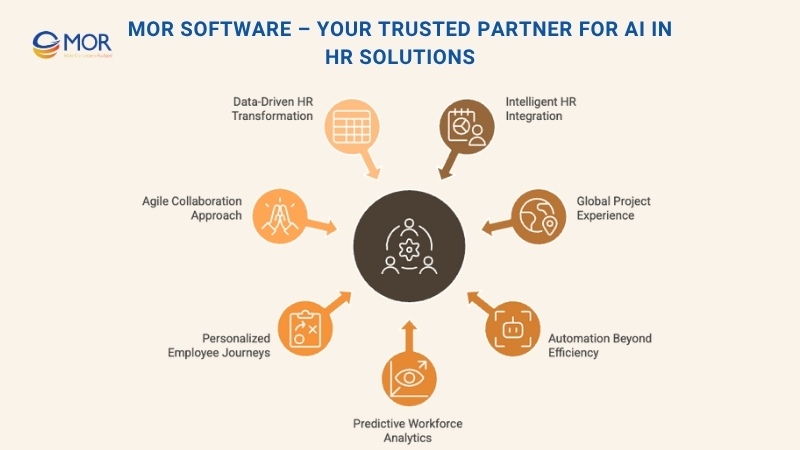
Our solutions go beyond automation. We design AI-driven HR ecosystems that:
- Automate HR operations such as attendance tracking, recruitment, and performance reviews.
- Use predictive analytics to forecast turnover, identify top talent, and recommend development paths.
- Deliver personalized employee experiences that improve satisfaction and retention.
Each project is built through close collaboration, agile methods, and measurable outcomes. Whether you’re modernizing legacy systems or launching a new HR platform, we can help you turn data into better workforce decisions.
Contact us to explore how MOR Software can help your organization unlock the full potential of AI in HR.
Conclusion
AI in HR is no longer a future trend, it’s a strategic advantage. From hiring and training to engagement and retention, it empowers businesses to make faster, smarter, and fairer workforce decisions. With proven expertise in AI, data analytics, and HR software development, MOR Software helps organizations build intelligent, human-centered systems that drive real impact. Contact us today to explore how AI can elevate your HR strategy and performance.
MOR SOFTWARE
Frequently Asked Questions (FAQs)
What is the role of AI in HR?
AI in HR uses technologies like machine learning, predictive analytics, and natural language processing to automate and enhance processes that usually depend on human judgment. It supports recruitment, employee engagement, performance evaluation, and data-driven decision-making.
What AI tools are used in HR?
Common AI tools in HR include Diversio for enterprise analytics, CultureAmp for employee feedback, Visier for workforce insights, and PredictiveHR for performance forecasting. These tools simplify hiring, improve retention, and help organizations make smarter workforce decisions.
Is AI replacing HR?
AI is transforming HR work but not replacing it. Automation helps with repetitive tasks, while people remain essential for leadership, empathy, and strategic planning. The combination of human expertise and AI creates stronger, people-centered HR functions.
How can HR use generative AI?
Generative AI helps HR teams analyze large datasets, summarize patterns, and generate reports or visual dashboards. It also creates job descriptions, training materials, and communication templates, making HR operations faster and more efficient.
How can HR professionals learn AI?
HR professionals can strengthen their AI skills by taking specialized AI courses for HR. These programs improve data literacy, teach how to use AI in HR ethically, and show how to manage risks and reduce hiring bias, helping HR leaders stay competitive.
How much is AI used in HR?
Only about 9% of HR teams currently use AI, compared to 25–26% in other departments. However, companies adopting AI report up to 40% cost savings and 60% higher revenue through better automation and smarter workforce management.
Can AI help reduce bias in HR?
AI cannot remove bias entirely, but it can significantly reduce it. Structured algorithms and consistent data analysis make hiring and performance reviews more objective, improving fairness and inclusion across the organization.
What skills are needed to work with AI in HR?
HR professionals need strong data literacy, analytical thinking, and a clear understanding of how AI tools function. They also need soft skills like ethical judgment, adaptability, and communication to align technology with human values.
Is AI a threat to HR?
AI is not a threat to HR but a valuable partner. It automates repetitive work, allowing HR professionals to focus on strategic planning, culture building, and employee development, which enhances overall organizational performance.
Which company replaced HR with AI?
IBM has automated most of its HR operations using AI, with nearly 94% of routine HR tasks now handled by artificial intelligence. This allows human staff to dedicate more time to leadership, innovation, and complex decision-making.
Rate this article
0
over 5.0 based on 0 reviews
Your rating on this news:
Name
*Email
*Write your comment
*Send your comment
1